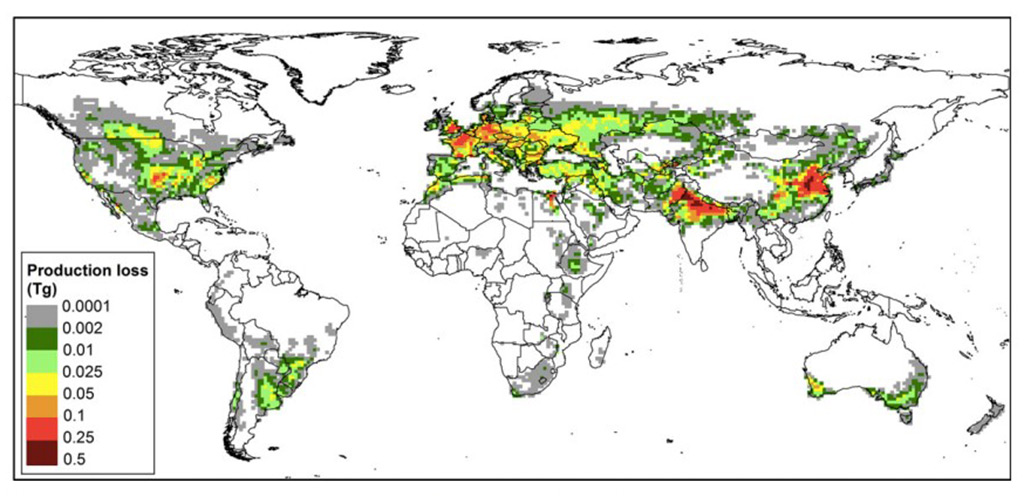New Study Finds Ozone Pollution Reduces Global Wheat Productivity
[ad_1]
By Mariana Surillo
One of the key findings of the 2016 U.S. Global Change Research Program Climate Health Assessment was that rising carbon dioxide levels lower the nutritional value of food crops, including wheat. The Intergovernmental Panel on Climate Change (IPCC) Fifth Assessment Report concluded that higher levels of ozone would damage crops and that interactions between CO2, temperature, water and nitrogen as they affect crops yields were complex and difficult to predict. A new Global Change Biology study, looking at the global impacts of ozone on crop productivity, builds on this existing evidence that ozone pollution reduces global wheat yield. The study found ozone pollution reduces wheat yields by ten percent in the northern hemisphere and roughly five percent in the southern hemisphere. Importantly, the study sheds new light on how changing climate and agriculture practices to adapt to a changing climate may exacerbate ozone impacts on wheat yield in the future and impair the efforts to achieve Sustainable Development Goals (SDGs) for nutrition and health.
“For the first time, our research answers important questions about how ozone pollution is causing the loss of wheat production on a global scale,” said co-author Elizabeth Ainsworth, Ph.D., a researcher at the University of Illinois in the Department of Plant Biology. “The main impetus of our research was to use a more mechanistic approach. In contrast, many studies on this topic take a purely statistical approach to estimate the effects of ozone on crop yields.”
Ozone, an air pollutant formed by the chemical reaction between sunlight, nitrogen oxides, and volatile organic compounds, poses direct and indirect threats to the environment and human health. Ozone pollution is associated with exacerbation of cardiovascular and respiratory diseases. Since the pollutant can reduce crop productivity, it is also responsible for increasing the risk of malnutrition and nutrient deficiency.
Production loss for wheat due to ozone modelled and percentage yield losses averaged for 2010-2012.
(Photo courtesy of Mills et al. 2018)
Ozone Pollution Affects Crop Productivity
According to a Food Security study, wheat provides 20% of global dietary protein and calorie intake. In the event of declining food availability, the impact will be most acutely felt among vulnerable populations, especially those in countries who depend on C3 crops (e.g. rice, wheat, and barley) for their primary source of zinc and iron. C3 plants, are plants that have a unique mechanism for carbon fixation during the process of photosynthesis. In C3 crops, elevated levels of ozone pollution impact photosynthesis, negatively affecting crop growth and seed production.
“To achieve United Nations Sustainable Development goals to increase food supply and improve agriculture, one of the potential tools farmers have is to increase irrigation,” said Ainsworth. “So, our study looked at the impact of ozone pollution in places where irrigation could be increased to improve yield.”
However, according to the study led by Gina Mills, the combined impacts of ozone pollution and added irrigation can increase crop losses. Using a modelling approach that examines ozone concentration and plant uptake of ozone, the research team found adding irrigation will improve certain conditions, such as soil moisture. But added irrigation also causes pores in the leaves to stay open for a longer time, increasing sensitivity to ozone.
Adaptation and Mitigation Strategies in A Changing Climate
Moving forward, Ainsworth believes providing an environment that incentivizes economic growth and does not produce ozone pollution is key to optimizing future crop yields. According to Ainsworth, one of the best strategies to mitigate ozone pollution and address the negative agricultural impacts is to reduce the emissions of ozone precursor gases, including nitrogen oxides and volatile organic compounds , from vehicles, biomass burning, power plants, and other sources of combustion.
Further, Ainsworth says the complex interaction of air pollution, climate change, and crop production has increased efforts focused on the genetics and biotechnological advances of crops. To address this, her new research focuses on identifying genotypes that are more tolerant to ozone.
Results from this study build evidence that ozone pollution reduces global wheat yield. Mitigating the negative effects of ozone on crop yields will help achieve the Sustainable Development Goals (SDGs) for nutrition and health. As the world population continues to grow, efforts to reduce food loss due to climate change is essential for providing food security and decreasing the proportion of undernourished people worldwide.
CO2 and Nutrition
[ad_2]


